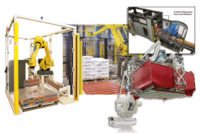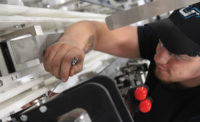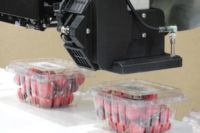End-of-Line Packaging: How to Finish Strong

There’s a simple, but knowing saying that applies to athletics along with most undertakings in life and in packaging: It’s not how you start, but how you finish.
We’ve taken that to heart with our cover story on end-of-line packaging that provides an overview of these crucial systems. It includes ways to improve your operations whether you are considering a new installation or want to optimize an older “workhorse” when new machinery can’t be justified.
We asked our experts to set the table by identifying key trends affecting downstream packaging operations for consumer packaged goods companies. One of those is the influence of mass merchandisers, which have gained an ever-stronger voice for packaging that appears in their distribution systems and stores.
“Over the past five years there has been an increasingly important role that the mass merchandisers have played in how a food or beverage product is to be packaged for shipment,” offers Dale Andersen, president & CEO, Delkor Systems. “That may be changing the shipper to reduce packaging material content, increasing the variety of product mix and pack patterns, or more recently the addition of a variety of both Retail Ready and Shelf Ready concepts to the mix. The result now requires packaging machinery manufacturers to develop a new generation of equipment that is engineered with adaptability and flexibility to handle a much greater range of packaging options.”

High-level palletizers like this are a familiar sight for many packagers, though today’s downstream machines are asked to handle a greater range of packaging formats than ever before.
Footprints matter
Troy Snader, VP of sales for Brenton Engineering div. of Pro Mach, centers the market’s needs on four essential requirements: Space, speed, sustainability and payback. “All companies would rather increase output in the same footprint than expand buildings or build new ones,” he says. “Because of this, increased throughput in the same footprint has become a focus of many companies. Due to constant margin pressures from external influences and trend to ‘go green’, companies are placing a sharp focus on total cost of ownership including utility usage and carbon footprint.”“While more packaging provides billboarding for marketing, food and beverage manufacturers are balancing that with reducing their packaging to cut costs,” says Rodney Erickson, senior beverage account development director for Intelligrated. “Plus there’s a significant push by major retailers to reduce both primary and secondary packaging for ‘green’ initiatives and to reduce packaging and waste handled at the store level. Marketing-driven packaging changes the flow downward through all bottlers. This typically requires equipment changes including new equipment to handle these changes.”
Brian Jackson, global account manager, Lantech, distills the market into four drivers:
- Cost Savings: Reduction of packaging material including corrugated and the use of thin fiberboard and conversion to trays;
- Packaging changes and package quality with different bottle/package designs that are cost- and marketing- driven to make the goods visually exciting/appealing to customer;
- Eliminating delivered “product waste” including out-of-date and damaged product in the supply chain;
- Productivity optimization in manufacturing, operations, and distribution.
Dan Schmidt, business development manager, ITW Muller, notes that food and beverage manufacturers are seeking to make more data-driven decisions: “This is with the caveat that any solution must also be easy to implement.”
“Another driver is the need to change from one packaging format to another quickly, and most importantly, with the ability to immediately return to full production speed,” adds Andersen. “The cost of adjusting a packaging machine post-changeover is too prohibitive in today’s packaging environment.”
Materialistic tendencies
Of course, the connection between machinery and materials is an intimate one, and trends on one side of this equation tend to affect the other side. Here are some of the materials changes that these machinery managers point to making an impact.
Snader sees reduced materials usage, particularly corrugated, noting examples such as moving to corner boards and stretch wrapping on palletizing for primary packaged goods versus palletizing secondary cases and stretch wrapping. “There is no industry where this is more noticeable than the beverage industry,” he says. “PET is becoming thinner and corrugated is nearly nonexistent in multipacks and in palletizing operations.”
Erickson concurs: “Manufacturers are using more shrink film packaging and reducing corrugate, resulting in more fragile pallet loads. This can present speed and handling issues for a palletizer.”

Robots are finding a place in hazardous duties, such as for placement of corner boards. That’s become a growth market as the use of corrugated shrinks in response to sustainability improvements.
Primary package changes affect downstream
And not only palletizers, stretch wrappers and other downstream operations are likewise affected.“The reduction of primary packaging has had a major impact on stretch wrapping across almost all food and beverage manufacturers,” observes ITW Muller’s Schmidt. “As customers have moved from wrapping product in sturdy corrugated boxes to wrapping the same product in trays or just on [corrugated] pads, it has made the end-of-the-line stretch wrapping operation much more critical. Customers have been looking for ways to improve load containment.
“The other major material trend is the introduction of thinner gauge stretch films in an effort to reduce stretch film costs and waste,” Schmidt continues. “Often, this can be in direct conflict with food and beverage customer’s need to improve load containment. If not done carefully, customers can increase costs because these thinner films can require additional wraps to get the same load containment or the stability of the load will be negatively impacted and cause an increase in load damage.
“However, if done correctly, this can be an effective solution. The real key to minimizing film usage and optimizing load containment is to evaluate the entire stretch wrapping system to ensure the right film and right equipment for your specific application.”
The trends of sustainability and downgauged stretch films are global ones, according to Sven Borghoff, senior business development manager, palletising and packaging systems, BEUMER Group GmbH & Co., a supplier of stretch-hood systems. He says, “We have customers in Europe that are operating stretch-hood systems with 40-micron or 50-micron films. We are currently modifying a 2005 system to operate with 30 microns.”
He sees this as a trend that will work its way stateside. “The film converters located in the NAFTA region are just starting to ramp up their technical capabilities in order to make those products also available,” Borghoff reports. “This trend will and has to take place in the U.S. as well, but will be delayed.”
A role for robotics
Automation in the form of robots has played a growing role to provide labor reduction, prevent on-the-job accidents, and reduce changeover time, according to Snader. “Our experience has shown that robots are not a solve-all solution for labor issues,” he cautions. “However, there are still many places robots can take the place of potentially dangerous jobs.”
One of those mentioned earlier: Placement of corner boards on pallets. “Most companies manually place corner boards onto pallets during the stretch wrapping process,” explains Snader. “That’s an accident waiting to happen. With robotic corner board placers, that has been transformed into managed production and higher efficiency.”
Intelligrated cites the case of a major beverage manufacturer as an example of a packager and supplier developing the best solution without trying to force a robot into the equation. The manufacturer wanted to implement a robotic palletizing solution, but the local plant was uncomfortable with the switch from a conventional machine. Also, the robotics-only palletizing solution could not provide the cycle time they required. The team developed a hybrid machine that satisfied the desire to incorporate robotics while providing a conventional palletizing machine that the plant was comfortable with.
While your end-of-line operations may not earn your company Line of the Year recognition, improvements are always welcome, even if it’s the satisfaction of spurring more efficiency from a workhorse machine. F&BP
For More Information:
BEUMER Group GmbH & Co.
732-893-2800; www.beumer.com
Brenton Engineering Div. Pro Mach
800-535-2730; www.brentonengineering.com
Delkor Systems
763-783-0855; www.delkorsystems.com
Intelligrated
877-315-3400; www.intelligrated.com
ITW Muller
800-628-6787; www.itwmuller.com
Lantech
800-866-0322; www.lantech.com
Four ways to improve your downstream operations
We solicited our experts for ways that customers could improve their end-of-line operations without the need to add new machinery. Here were some suggestions:Investigate what retrofits are available for the equipment. It is not unusual for a stretch wrapper to last 15 to 20 years. In that time, numerous advancements have been made that can make the equipment operate more efficiently. There may be simple and affordable ways to increase productivity, reduce maintenance, and minimize film usage without having to invest in new machinery. Field service technicians can perform an audit on your machine and make recommendations on what enhancements can be made to improve performance and keep your machine running for many more years to come. The payback on this type of investment is usually significant. I strongly suggest that the customer contact the equipment manufacturer to find out what is available for their specific equipment.
Dan Schmidt, ITW Muller
Have the vendor conduct a machine audit.
A small up-front investment nearly always pays back many times over in efficiency and speed. Audits of machinery can point to faulty or worn parts producing downtime and decreased speed. Companies either don’t have the internal expertise to perform audits, or never take the time. With an audit from the machine manufacturer and implementation of new parts and “tune-up”, the end user not only gets payback for the visit, but increased throughput.
Troy Snader, Brenton
Companies can modify existing machinery...
to provide gentle handling required for today’s reduced packaging and provide additional flexibility to adapt to packaging changes and reduce changeover time.
Rodney Erickson, Intelligrated
Create packaging standards and a process quality control loop to adhere to the standards. Develop good standards for a shippable product and then test, check, and adjust if necessary.
Brian Jackson, Lantech
Advice on new machinery installations
We asked our experts for one piece of advice they’d like to share for installs of new equipment. Here’s what they told us:Consider Total Value of Ownership rather than Total Cost of Ownership
To achieve long-term success, a company needs sustainable development, reliable partnerships and a 360 degree perspective. This involves switching the thinking from cost to value. Total Cost of Ownership (TCO) has traditionally been the main focus of business activity. We feel that aside from the highest possible product quality, it is important to include environmental and social factors. That why we propose to follow the Total Value of Ownership (TVO) approach. For example, BEUMER has used water-based-VOC paints in industrial applications since the early 90´s to protect the environment from unnecessary hazards. Only a fraction of customers are including this aspect in their decision-making process.
A wider perspective than just investment cost will lead to more satisfied business outcomes.
Sven Borghoff, BEUMER Group
Allow in-depth training
We have developed a two-tier approach to training of new staff for a packaging line. At time of installation we conduct typical line orientation training. But we then follow-up with a customized formal training program about 4 to 8 weeks following the install. This formal training is divided into separate programs for maintenance and operators, and provides the team with an in-depth understanding of the how, why and when of the machinery. We have found that the training is not complete until after this more in-depth training.
Dale Andersen, Delkor Systems
Allow proper time for proper training
What we see more often than not is the customer’s installation team is under a great deal of pressure to bring the equipment up and running deliverable production. If possible, the customer should build enough time into their schedule to allow for training on the fully functioning system. System training is often done while the equipment is being run in a full production mode. This approach doesn’t allow for training in areas such as situational trouble shooting or preventive maintenance evaluations.
Earl Wohlrab, Intelligrated
Look at the stretch wrapping system as a whole
This means that the packager should understand what is most important to their operations and make sure that the stretch film, equipment and service they get helps them meet their overall goals. Too often, we see different people making the purchasing decisions for the film, the equipment and the service–and each of these people may have different motivations that are in conflict with the other. To maximize performance, minimize film usage, and optimize load containment, the customer must consider the whole system.
Dan Schmidt, ITW Muller
Provide ample time and materials at Factory Acceptance Testing (FAT)
This insures a shorter installation on-site and reduces stress at start-up. If the machinery can be tested thoroughly at a manufacturers site with ample quantity of materials and product, there is a positive cost benefit to quicker installation and a higher efficiency output in a shorter amount of time. Operators and plant personnel have greater confidence in the equipment, which translates to longer-term uptime and higher efficiency on the line.
Troy Snader, Brenton
Plan ahead
Companies should really think about current and potential future packages, and make sure flexibility is built into their systems to handle the unexpected.
Rodney Erickson, Intelligrated
Do it right the first time
Hire qualified, quality installation services and set packaging standards during the new installation process.
Brian Jackson, Lantech

Tape wrapper is said to cut pallet packaging waste
by up to 95% by volume, while keeping loads from tipping, shifting and vibrating.
Other options: Tape wrapper
An intriguing alternative to conventional stretch wrapping is a tape wrapper, which 3M Packaging introduced five years ago. Two years ago it released a new version that enables better ventilation to reduce product cooling times and the amount of pallet handling and wrapping required. The system is said to cut pallet packaging waste by up to 95% by volume, while keeping loads from tipping, shifting and vibrating. The system is designed with semi-automated wrapping, which ensures the proper stretch ratio and consistent banding patterns for optimized load stability, 3M states.Ginny Fox, global product manager, 3M Industrial Adhesives & Tapes Division, says the response has been favorable, especially in snack food and fresh produce markets. “Faced with increasing competition, packagers feel the pressure to deliver fresher product faster and with a focus on cost management and sustainability,” she says.
One trend she notes: A growth in the use of high-quality graphics on shipping boxes to differentiate products on the shelf and leverage brands. 3M’s adhesive holds loads securely yet can be removed without damaging the corrugate and other materials. Thus, boxes can be reused, providing another benefit.
“Sustainability is a driving force for customers to look for alternative ways to unitize their pallets,” says Fox. “A mindset in change is needed because packagers are used to using film. Once customers understand the strength isn’t compromised, their hesitations diminish.”
3M Packaging
800-362-3550; www.3M.com/packaging

Robotic wrapper is a portable system said to be
ideal for cased food and beverages.
Other options: Robotic film wrapper
ITW GaleWrap’s just-introduced GW-4100 robotic wrapper is a portable system said to be ideal for food and beverage case packed items. That’s according to Michael Klear, market development manager: “The versatility of the machine allows for stretch wrapping in multiple locations, so travel time to and from a stretch wrapper can be eliminated. It’s ideal for customers who are looking to increase productivity, reduce labor costs and add automation with minimal expense and without taking up valuable floor space. We find that it works great for customers who have limited space.”The system uses GaleWrap Oriented Film, which is described as a high-quality hemmed edge film with high holding force and post-wrap contraction to securely contain loads. It features a telescoping mast for accommodating loads to nearly seven feet high.
Klear sees the robotic wrapper as offering major labor-saving benefits over hand wrapping: It permits two loads to be wrapped in the time of one hand-wrapped load and eliminates inefficiencies by using just the right amount of film.
ITW GaleWrap
866-425-3727; www.galewrap.com
Looking for a reprint of this article?
From high-res PDFs to custom plaques, order your copy today!






